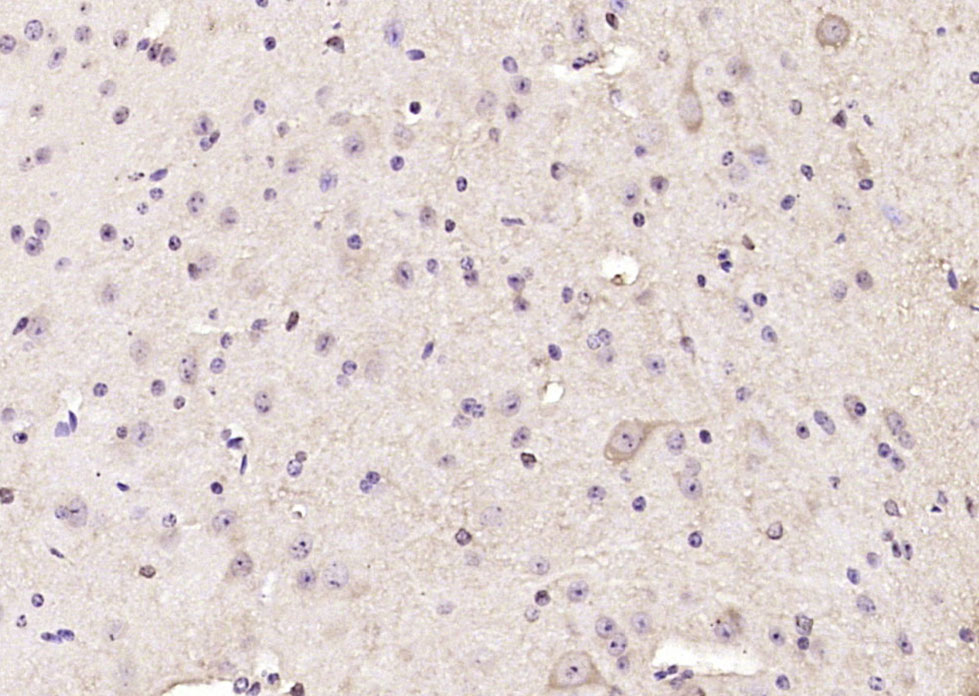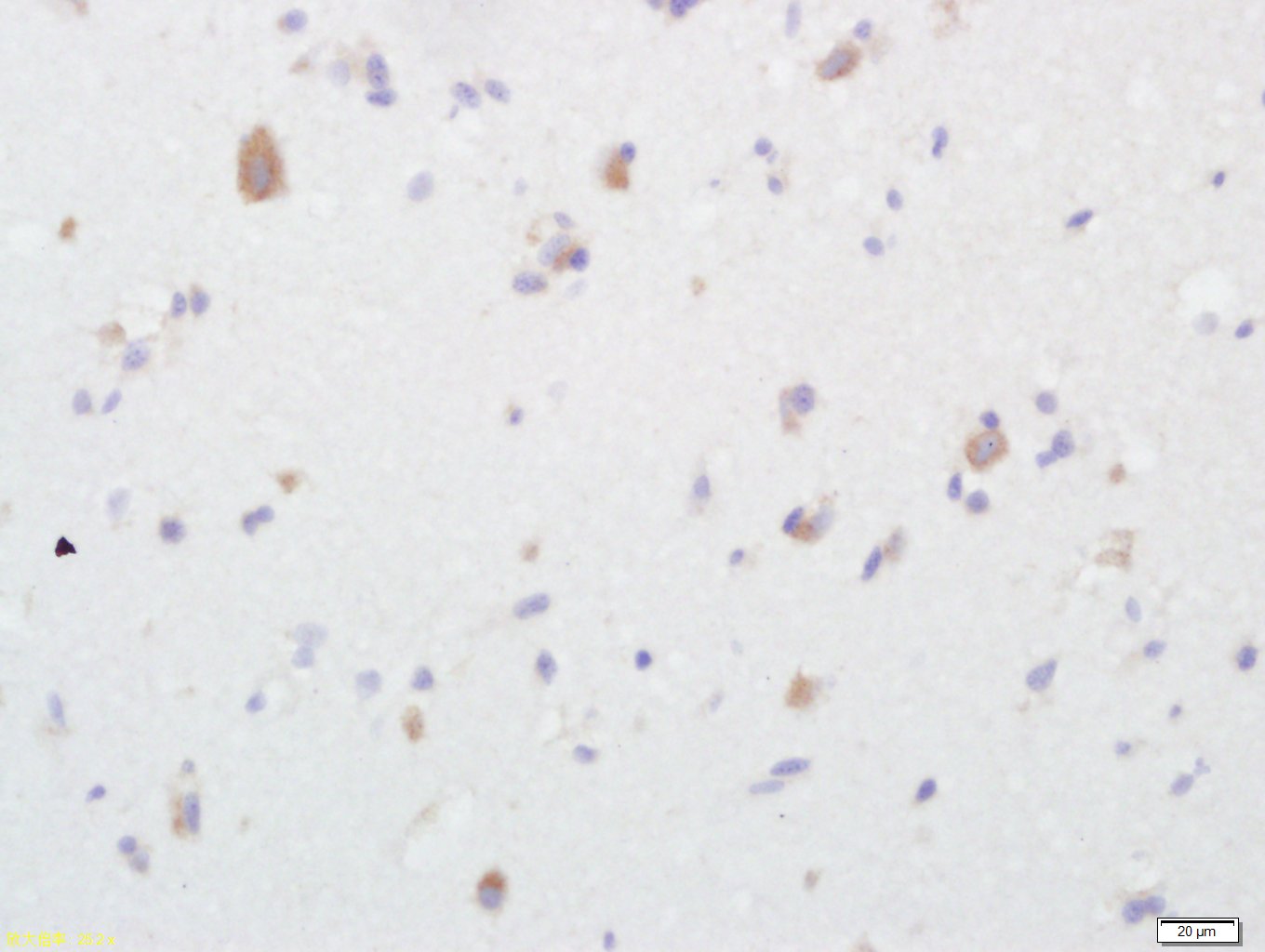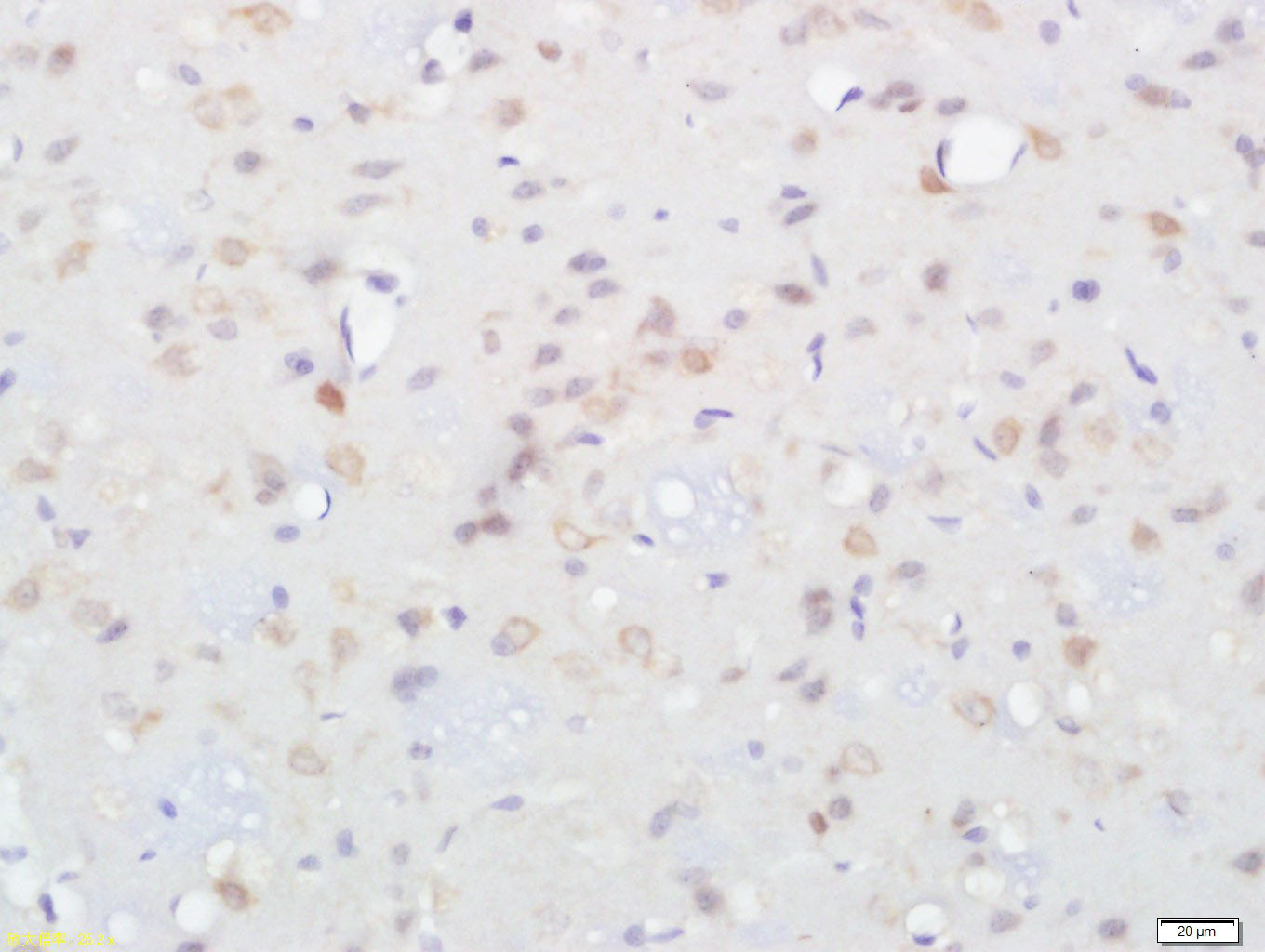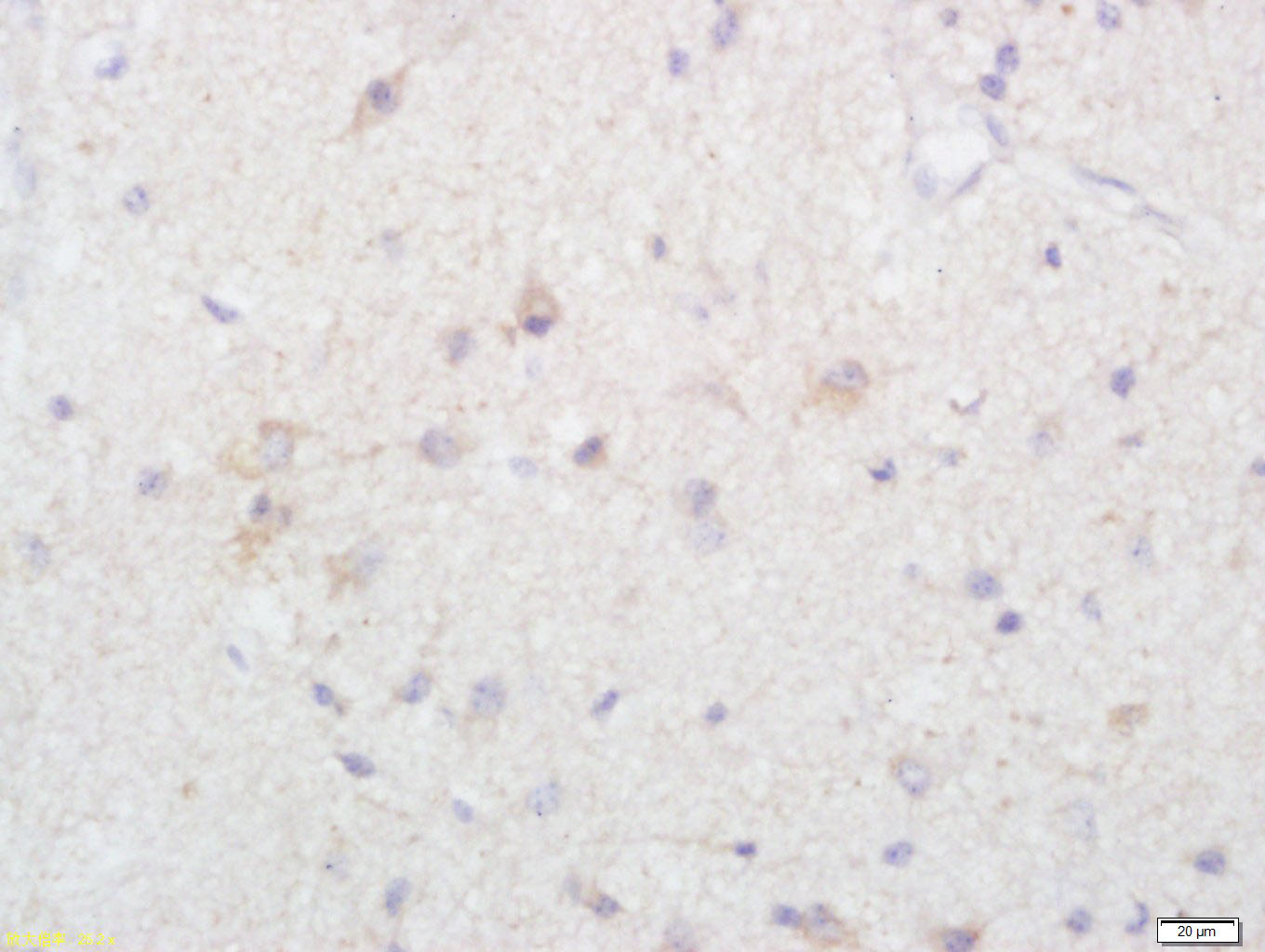
Rabbit Anti-alpha + beta Synuclein antibody
Alpha synuclein; Beta synuclein; NACP; Non A beta component of AD amyloid; Non A4 component of amyloid precursor; PARK1; PARK4; Parkinson disease familial 1; PD1; SNCA; SYUA_HUMAN; SNCB; SNCB protein; Synuclein alpha; Synuclein beta; SYUB_HUMAN.
View History [Clear]
Details
Product Name alpha + beta Synuclein Chinese Name 核突触蛋白α+β抗体 Alias Alpha synuclein; Beta synuclein; NACP; Non A beta component of AD amyloid; Non A4 component of amyloid precursor; PARK1; PARK4; Parkinson disease familial 1; PD1; SNCA; SYUA_HUMAN; SNCB; SNCB protein; Synuclein alpha; Synuclein beta; SYUB_HUMAN. Research Area Cell biology Neurobiology Alzheimer's Immunogen Species Rabbit Clonality Polyclonal React Species Human, Mouse, Rat, Zebrafish, (predicted: Chicken, Dog, Pig, Cow, Rabbit, ) Applications ELISA=1:5000-10000 IHC-P=1:100-500 IHC-F=1:100-500 ICC=1:100-500 IF=1:100-500 (Paraffin sections need antigen repair)
not yet tested in other applications.
optimal dilutions/concentrations should be determined by the end user.Theoretical molecular weight 14kDa Cellular localization cytoplasmic The cell membrane Form Liquid Concentration 1mg/ml immunogen KLH conjugated synthetic peptide derived from human alpha + beta Synuclein: 32-44/140 Lsotype IgG Purification affinity purified by Protein A Buffer Solution 0.01M TBS(pH7.4) with 1% BSA, 0.03% Proclin300 and 50% Glycerol. Storage Shipped at 4℃. Store at -20 °C for one year. Avoid repeated freeze/thaw cycles. Attention This product as supplied is intended for research use only, not for use in human, therapeutic or diagnostic applications. PubMed PubMed Product Detail Synucleins are small soluble proteins expressed primarily in neural tissues and in certain tumors. The family includes 3 known proteins, alpha synuclein, beta synuclein and gamma synuclein. All synucleins have in common a highly conserved alpha helical lipid binding motif with similarity to the class A2 lipid binding domains of the exchangeable apolipoproteins. The alpha and beta synuclein proteins are found primarily in brain tissue, where they are seen mainly in pre synaptic terminals. Alpha synuclein is believed to be a major component of Lewy bodies in Parkinson’s disease. Mutations in alpha synuclein are associated with rare familial cases of early onset Parkinson’s disease, Alzheimer’s disease and several other neurodegenerative illnesses.
Function:
May be involved in the regulation of dopamine release and transport. Induces fibrillization of microtubule-associated protein tau. Reduces neuronal responsiveness to various apoptotic stimuli, leading to a decreased caspase-3 activation.
Subunit:
Soluble monomer which can form filamentous aggregates. Interacts with UCHL1 (By similarity). Interacts with phospholipase D and histones.
Subcellular Location:
Cytoplasmic. Membrane bound in dopaminergic neurons. Also found in the nucleus.
Tissue Specificity:
Expressed principally in brain but is also expressed in low concentrations in all tissues examined except in liver. Concentrated in presynaptic nerve terminals.
Post-translational modifications:
Phosphorylated, predominantly on serine residues. Phosphorylation by CK1 appears to occur on residues distinct from the residue phosphorylated by other kinases. Phosphorylation of Ser-129 is selective and extensive in synucleinopathy lesions. In vitro, phosphorylation at Ser-129 promoted insoluble fibril formation. Phosphorylated on Tyr-125 by a PTK2B-dependent pathway upon osmotic stress.
Hallmark lesions of neurodegenerative synucleinopathies contain alpha-synuclein that is modified by nitration of tyrosine residues and possibly by dityrosine cross-linking to generated stable oligomers.
Ubiquitinated. The predominant conjugate is the diubiquitinated form (By similarity).
DISEASE:
Note=Genetic alterations of SNCA resulting in aberrant polymerization into fibrils, are associated with several neurodegenerative diseases (synucleinopathies). SNCA fibrillar aggregates represent the major non A-beta component of Alzheimer disease amyloid plaque, and a major component of Lewy body inclusions. They are also found within Lewy body (LB)-like intraneuronal inclusions, glial inclusions and axonal spheroids in neurodegeneration with brain iron accumulation type 1.
Defects in SNCA are the cause of Parkinson disease type 1 (PARK1) [MIM:168601]. A complex neurodegenerative disorder characterized by bradykinesia, resting tremor, muscular rigidity and postural instability. Additional features are characteristic postural abnormalities, dysautonomia, dystonic cramps, and dementia. The pathology of Parkinson disease involves the loss of dopaminergic neurons in the substantia nigra and the presence of Lewy bodies (intraneuronal accumulations of aggregated proteins), in surviving neurons in various areas of the brain. The disease is progressive and usually manifests after the age of 50 years, although early-onset cases (before 50 years) are known. The majority of the cases are sporadic suggesting a multifactorial etiology based on environmental and genetic factors. However, some patients present with a positive family history for the disease. Familial forms of the disease usually begin at earlier ages and are associated with atypical clinical features.
Defects in SNCA are the cause of Parkinson disease type 4 (PARK4) [MIM:605543]. A complex neurodegenerative disorder with manifestations ranging from typical Parkinson disease to dementia with Lewy bodies. Clinical features include parkinsonian symptoms (tremor, rigidity, postural instability and bradykinesia), dementia, diffuse Lewy body pathology, autonomic dysfunction, hallucinations and paranoia.
Defects in SNCA are the cause of dementia Lewy body (DLB) [MIM:127750]. A neurodegenerative disorder clinically characterized by mental impairment leading to dementia, parkinsonism, often with fluctuating cognitive function, visual hallucinations, falls, syncopal episodes, and sensitivity to neuroleptic medication. Brainstem or cortical intraneuronal accumulations of aggregated proteins (Lewy bodies) are the only essential pathologic features. Patients may also have hippocampal and neocortical senile plaques, sometimes in sufficient number to fulfill the diagnostic criteria for Alzheimer disease.
Similarity:
Belongs to the synuclein family.
SWISS:
P37840
Gene ID:
6620
Database links:Entrez Gene: 6620 Human
Entrez Gene: 6622 Human
Entrez Gene: 104069 Mouse
Entrez Gene: 20617 Mouse
Omim: 163890 Human
Omim: 602569 Human
SwissProt: P37840 Human
SwissProt: Q16143 Human
SwissProt: O55042 Mouse
SwissProt: Q91ZZ3 Mouse
Unigene: 271771 Human
Unigene: 90297 Human
Unigene: 17484 Mouse
Unigene: 200843 Mouse
Unigene: 1827 Rat
Unigene: 20352 Rat
Product Picture
Antigen retrieval: citrate buffer ( 0.01M, pH 6.0 ), Boiling bathing for 15min; Block endogenous peroxidase by 3% Hydrogen peroxide for 30min; Blocking buffer (normal goat serum,C-0005) at 37℃ for 20 min;
Incubation: Anti-Aipha synuclein Polyclonal Antibody, Unconjugated(SL11787R) 1:200, overnight at 4°C, followed by conjugation to the secondary antibody(SP-0023) and DAB(C-0010) staining
Tissue/cell: Rat brain tissue; 4% Paraformaldehyde-fixed and paraffin-embedded;
Antigen retrieval: citrate buffer ( 0.01M, pH 6.0 ), Boiling bathing for 15min; Block endogenous peroxidase by 3% Hydrogen peroxide for 30min; Blocking buffer (normal goat serum,C-0005) at 37℃ for 20 min;
Incubation: Anti-Aipha synuclein Polyclonal Antibody, Unconjugated(SL11787R) 1:200, overnight at 4°C, followed by conjugation to the secondary antibody(SP-0023) and DAB(C-0010) staining
Tissue/cell: Human brain glioma; 4% Paraformaldehyde-fixed and paraffin-embedded;
Antigen retrieval: citrate buffer ( 0.01M, pH 6.0 ), Boiling bathing for 15min; Block endogenous peroxidase by 3% Hydrogen peroxide for 30min; Blocking buffer (normal goat serum,C-0005) at 37℃ for 20 min;
Incubation: Anti-Aipha synuclein Polyclonal Antibody, Unconjugated(SL11787R) 1:200, overnight at 4°C, followed by conjugation to the secondary antibody(SP-0023) and DAB(C-0010) staining
Bought notes(bought amounts latest0)
No one bought this product
User Comment(Total0User Comment Num)
- No comment






 +86 571 56623320
+86 571 56623320
 +86 18668110335
+86 18668110335

